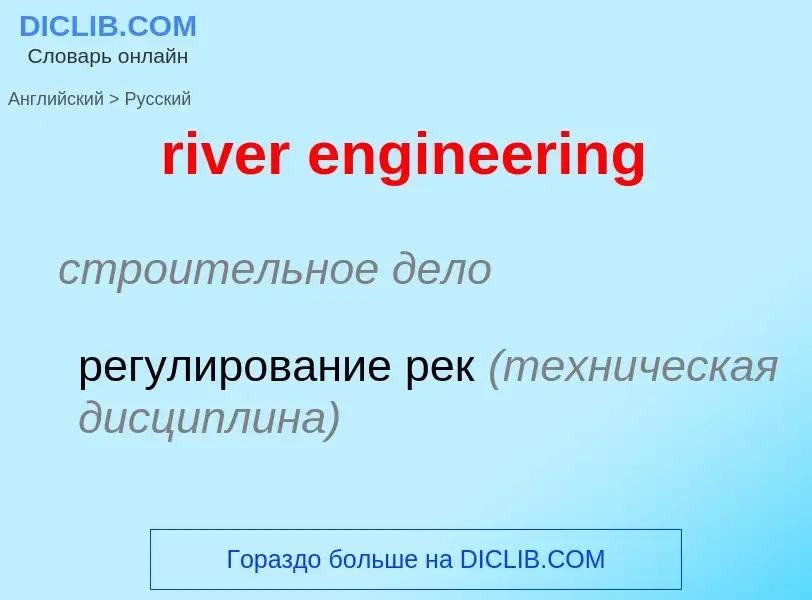Translation and analysis of words by ChatGPT artificial intelligence
On this page you can get a detailed analysis of a word or phrase, produced by the best artificial intelligence technology to date:
- how the word is used
- frequency of use
- it is used more often in oral or written speech
- word translation options
- usage examples (several phrases with translation)
- etymology
river engineering - translation to russian
строительное дело
регулирование рек (техническая дисциплина)
Wikipedia

River engineering is a discipline of civil engineering which studies human intervention in the course, characteristics, or flow of a river with the intention of producing some defined benefit. People have intervened in the natural course and behaviour of rivers since before recorded history—to manage the water resources, to protect against flooding, or to make passage along or across rivers easier. Since the Yuan Dynasty and Ancient Roman times, rivers have been used as a source of hydropower. From the late 20th century, the practice of river engineering has responded to environmental concerns broader than immediate human benefit. Some river engineering projects have focused exclusively on the restoration or protection of natural characteristics and habitats.
Hydromodification encompasses the systematic response to alterations to riverine and non-riverine water bodies such as coastal waters (estuaries and bays) and lakes. The U.S. Environmental Protection Agency (EPA) has defined hydromodification as the "alteration of the hydrologic characteristics of coastal and non-coastal waters, which in turn could cause degradation of water resources." River engineering has often resulted in unintended systematic responses, such as reduced habitat for fish and wildlife, and alterations of water temperature and sediment transport patterns.
Beginning in the late 20th century, the river engineering discipline has been more focused on repairing hydromodified degradations and accounting for potential systematic response to planned alterations by considering fluvial geomorphology. Fluvial geomorphology is the study of how rivers change their form over time. Fluvial geomorphology is the cumulation of a number of sciences including open channel hydraulics, sediment transport, hydrology, physical geology, and riparian ecology. River engineering practitioners attempt to understand fluvial geomorphology, implement a physical alteration, and maintain public safety.: 3–13ff


![The [[Mississippi River]] basin is the largest in the United States. The [[Mississippi River]] basin is the largest in the United States.](https://commons.wikimedia.org/wiki/Special:FilePath/Mississippi River basin.jpg?width=200)
![dredge]] [[barge]] on the [[Vistula River]], [[Warsaw]], [[Poland]]. dredge]] [[barge]] on the [[Vistula River]], [[Warsaw]], [[Poland]].](https://commons.wikimedia.org/wiki/Special:FilePath/Piaskarka Wisła Warszawa 002.jpg?width=200)
![Flood control structures at the [[Thames Barrier]] in London. Flood control structures at the [[Thames Barrier]] in London.](https://commons.wikimedia.org/wiki/Special:FilePath/Thames Barrier 03.jpg?width=200)

![A water-powered [[mine hoist]] used for raising ore, ca. 1556 A water-powered [[mine hoist]] used for raising ore, ca. 1556](https://commons.wikimedia.org/wiki/Special:FilePath/Agricola1.jpg?width=200)
![A drawing for a [[steam locomotive]]. Engineering is applied to [[design]], with emphasis on function and the utilization of mathematics and science. A drawing for a [[steam locomotive]]. Engineering is applied to [[design]], with emphasis on function and the utilization of mathematics and science.](https://commons.wikimedia.org/wiki/Special:FilePath/Booster-Layout.jpg?width=200)
![fluid flow]] and the [[heat equation]]s. fluid flow]] and the [[heat equation]]s.](https://commons.wikimedia.org/wiki/Special:FilePath/CFD Shuttle.jpg?width=200)
![rotor and stator]] as well as the [[steam cycle]] all need to be carefully designed and optimized. rotor and stator]] as well as the [[steam cycle]] all need to be carefully designed and optimized.](https://commons.wikimedia.org/wiki/Special:FilePath/Dampfturbine Montage01.jpg?width=200)
![Radar, [[GPS]], [[lidar]], ... are all combined to provide proper navigation and [[obstacle avoidance]] (vehicle developed for 2007 [[DARPA Urban Challenge]]) Radar, [[GPS]], [[lidar]], ... are all combined to provide proper navigation and [[obstacle avoidance]] (vehicle developed for 2007 [[DARPA Urban Challenge]])](https://commons.wikimedia.org/wiki/Special:FilePath/ElementBlack2.jpg?width=200)

![Genetically engineered mice expressing [[green fluorescent protein]], which glows green under blue light. The central mouse is [[wild-type]]. Genetically engineered mice expressing [[green fluorescent protein]], which glows green under blue light. The central mouse is [[wild-type]].](https://commons.wikimedia.org/wiki/Special:FilePath/GFP Mice 01.jpg?width=200)
![Offshore platform, [[Gulf of Mexico]] Offshore platform, [[Gulf of Mexico]]](https://commons.wikimedia.org/wiki/Special:FilePath/Gulf Offshore Platform.jpg?width=200)
![[[Hoover Dam]] [[Hoover Dam]]](https://commons.wikimedia.org/wiki/Special:FilePath/Hoover dam from air.jpg?width=200)
![Kismet]] can produce a range of facial expressions. Kismet]] can produce a range of facial expressions.](https://commons.wikimedia.org/wiki/Special:FilePath/Kismet-IMG 6007-gradient.jpg?width=200)
![[[Leonardo da Vinci]], seen here in a self-portrait, has been described as the epitome of the artist/engineer.<ref name="Bjerklie, David"/> He is also known for his studies on [[human anatomy]] and [[physiology]]. [[Leonardo da Vinci]], seen here in a self-portrait, has been described as the epitome of the artist/engineer.<ref name="Bjerklie, David"/> He is also known for his studies on [[human anatomy]] and [[physiology]].](https://commons.wikimedia.org/wiki/Special:FilePath/Leonardo da Vinci - presumed self-portrait - WGA12798.jpg?width=200)
![The ''[[InSight]]'' lander with solar panels deployed in a cleanroom The ''[[InSight]]'' lander with solar panels deployed in a cleanroom](https://commons.wikimedia.org/wiki/Special:FilePath/PIA19664-MarsInSightLander-Assembly-20150430.jpg?width=200)
![aqueducts]] to bring a steady supply of clean and fresh water to cities and towns in the empire. aqueducts]] to bring a steady supply of clean and fresh water to cities and towns in the empire.](https://commons.wikimedia.org/wiki/Special:FilePath/Pont du Gard BLS.jpg?width=200)
![The [[International Space Station]] is used to conduct science experiments in space The [[International Space Station]] is used to conduct science experiments in space](https://commons.wikimedia.org/wiki/Special:FilePath/The station pictured from the SpaceX Crew Dragon 5 (cropped).jpg?width=200)
![The application of the steam engine allowed coke to be substituted for charcoal in iron making, lowering the cost of iron, which provided engineers with a new material for building bridges. This bridge was made of [[cast iron]], which was soon displaced by less brittle [[wrought iron]] as a structural material The application of the steam engine allowed coke to be substituted for charcoal in iron making, lowering the cost of iron, which provided engineers with a new material for building bridges. This bridge was made of [[cast iron]], which was soon displaced by less brittle [[wrought iron]] as a structural material](https://commons.wikimedia.org/wiki/Special:FilePath/The world's first iron bridge.jpg?width=200)
![Engineers, scientists and technicians at work on target positioner inside [[National Ignition Facility]] (NIF) target chamber Engineers, scientists and technicians at work on target positioner inside [[National Ignition Facility]] (NIF) target chamber](https://commons.wikimedia.org/wiki/Special:FilePath/Worker inside the target chamber of the National Ignition Facility.jpg?width=200)
![Graphic representation of a minute fraction of the WWW, demonstrating [[hyperlink]]s Graphic representation of a minute fraction of the WWW, demonstrating [[hyperlink]]s](https://commons.wikimedia.org/wiki/Special:FilePath/WorldWideWebAroundWikipedia.png?width=200)
